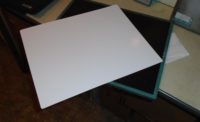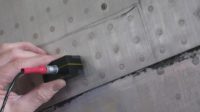The Level III (SNT-TC-1A) / Level 3 (NAS 410) population of inspectors is graying and looking forward to retirement. Hence, there is a current shortage of qualified Level IIIs in all NDT methods, and that will continue to be a problem for the foreseeable future. There is nothing wrong with having a career as a Level II inspector. It is a relatively good-paying job that can provide job satisfaction while having the advantage that the job does not follow you home. While there are many opinions on what makes a good Level III, this article seeks to suggest practical means by which a Level II inspector can progress toward the goal of being a competent Level III.
Technically, all you have to accomplish to become a Level III is to pass a series of tests that are more difficult than those you took to achieve Level II status. Practically speaking, just about any competent inspector can be coached through the exams and be certified as a Level III by the company. However, just because you pass some tests does not make you a competent Level III. There are different expectations of what a good Level III should be. Management has a certain viewpoint, and the Level IIs working under the new Level III have somewhat different expectations. Management expects them to be the technical lead, to manage the NDT program in compliance with customer requirements, as well as to mentor and lead the Level IIs. Level IIs expect their Level III to teach them more, to be approachable, and to back them up when they make an accurate but unpopular assessment of inspection results. One expectation on both sides of the equation is that the Level III is the technical representative regarding the two parties. If there is a question as to the validity of what the inspector is accepting or rejecting, only the Level III certified in the same inspection method, not the manager, can overrule the original disposition. Such a responsibility infers that they have superior judgment when it comes to evaluating the acceptability of the inspection results.
What does it take to go to the next Level? First, the company or the current Level III may not have this same desire, so managing one’s expectations is crucial. Expecting a company to pay for the development of a new Level III is often unrealistic. Such a reality should not stop you from moving forward. A nationally recognized certification is the ideal way to demonstrate to everyone within a company that Level III status is deserved. Just as ASQ certification as a Certified Quality Auditor (CQA) or Certified Quality Engineer (CQE) validates expertise, ASNT’s Level III certification demonstrates a broad capability in the particular inspection discipline. To reach this goal means to study a broad variety of resources for many hours on your own time. No one is just handed a Level III certificate. It normally comes as a result of dedication and hard work. ASNT now has many approved local testing facilities so traveling to another city or state is no longer necessary as it was twenty years ago.
The ASNT exams cover a broad spectrum of knowledge, covering both industrial and aerospace applications. Each of the exams have a section covering code or specification comprehension, so it is crucial that you be familiar with such documents. For instance, if you are studying for the four-hour ultrasonic exam, you need to be familiar with a weld contact inspection code such as AWSD1.1/D1.1M as well as immersion specifications such as ASTM E2375 or AMS-STD-2154. The ASNT exams normally have a unique practice code/specification that is very similar to these mentioned herein. The other NDT disciplines have their distinctive divisions between aerospace and industrial standards.
The difference between aerospace and industrial application is diverse for each inspection discipline. While industrial magnetic particle inspection is often portable in nature, you also need to be familiar with permanent bench-based applications. Industrial liquid penetrant applications are most often portable Method C, either Type I or II. However, in aerospace, Methods A, B, and D type penetrant systems are almost exclusively used. You need to understand the nuances of these inspection techniques. Radiography offers perhaps the widest range of applications or modalities, primarily through the source of radiation, whether it is electromagnetic or isotope based, as well as whether film or digital modalities are used to capture the image. Some eddy current inspectors only work on aircraft hardware whether they be airframe or engine components, while some inspectors only work with industrial applications such as inspection of heat exchanger tubing. Familiarity with both sectors is crucial to be able to pass this ASNT four-hour exam. It is also necessary for the candidate to have the necessary math skills to navigate the calculations associated with each nondestructive test method. If you lack the necessary math skills, obtain the needed training to pass the test(s).
NDT
A Quality Special Section
If you fail the ASNT Level III exam, don’t be discouraged. Understand the reasons for the failure, bolster your knowledge base, and take the exam again. Perseverance pays off in the long run. Failure is a good tutor that we can all learn from. There is a major difference between having ASNT Level IIIs or only being a company Level III. The ASNT Level III certification, perhaps the most difficult NDT test to pass in the world, brings instant credibility and normally an elevated salary to the bearer. If you pass one exam, go for another discipline. To be qualified to take the exam, you have to have the necessary time as a Level II in that discipline, so working for a company that uses multiple test disciplines has an advantage. Some inspectors move from company to company in order to pick up the necessary experience in multiple disciplines.
Once you have your Level III certification, what does it take to be a proficient Level III? The Level III is the only one who can authorize procedures and techniques. Therefore, you need to have the necessary writing skills. If you don’t write well, take a writing class. If you can’t type, take a typing class. If engineering drawings mystify you, take a course on blueprints. Computer skills are essential for this position. If you are not good with computers, take a computer class. Proficiency in Microsoft Word and Excel is normally expected, so perhaps a program specific class will be helpful. Understanding the product forms that you may encounter such as castings, weldments and wrought material is crucial, so a metallurgy class might be in order. Understanding of ancillary processes that supplement production of components such as welding, heat treatment, and wet processes is important and contributes to your overall understanding of conditions that can impact your inspections.
A good Level III should have problem solving skills, much of what can only be learned from encountering problems and fixing them. A good Level III also has to have people skills. They are expected to be able to interface with customers in a professional manner. They should be able mentors for the Level IIs, not withholding knowledge, but developing them into more capable inspectors. Level IIs often need encouragement and respect; a good Level III does just that. Since the inspection process is dependent upon the integrity of the inspector, Level IIIs should lead in this respect. This means being intolerant to taking illegal shortcuts and resisting any pressure to accept non-compliant product.
Once again, just being a Level II is a good career. However, some Level II jobs are physical in nature, whether it is working on never-ending construction sites or processing heavy parts through a magnetic particle or penetrant line. Inspectors would do well to contemplate whether they want to be doing the same job ten or twenty years from now. Level III jobs are normally less physical and provide a pathway to higher compensation and to management careers. Don’t let a Level III or management hold you back. Work hard and do what it takes to reach the next level.



